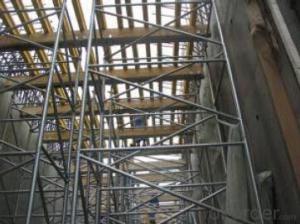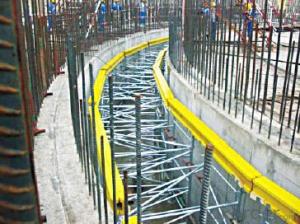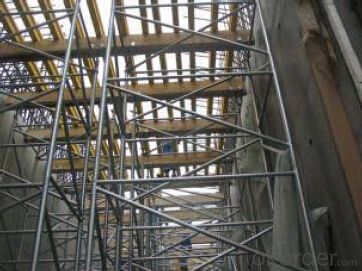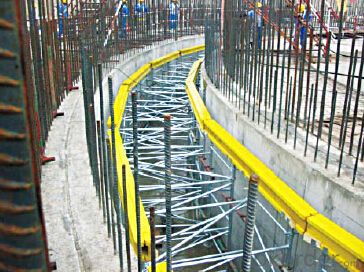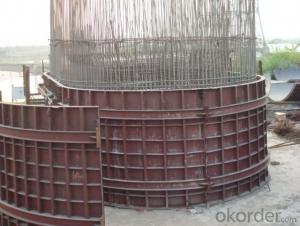Tower scaffolding for Formwork and Scaffolding Systems
- Loading Port:
- Tianjin
- Payment Terms:
- TT OR LC
- Min Order Qty:
- 50 m²
- Supply Capability:
- 1000 m²/month
OKorder Service Pledge
Quality Product, Order Online Tracking, Timely Delivery
OKorder Financial Service
Credit Rating, Credit Services, Credit Purchasing
You Might Also Like
Tower Scaffolding
Shoring tower is an effective supporting system. It is easy to assemble and dismantlement, and
has excellent stability and bearing capacity. It has been widely used in the construction of industry
& residential buildings , bridges, tunnels and dam project, etc.
Characteristics:
◆ High degree of standardization.
◆ Easy storage and transportation
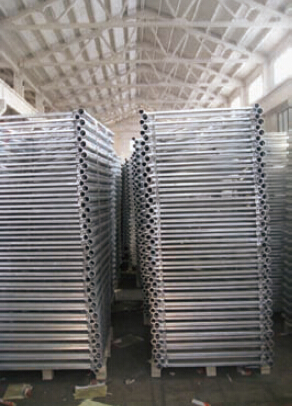
- Q: Can steel formwork be used in underground structures?
- Yes, steel formwork can be used in underground structures. Steel formwork is a versatile and durable construction material that can withstand the challenging conditions of underground structures. It offers excellent strength and stability, making it suitable for constructing walls, columns, and slabs in underground spaces. One of the key advantages of steel formwork is its ability to resist the pressure exerted by the surrounding soil and water. Underground structures often face high hydrostatic pressure, and steel formwork can easily withstand this pressure without deforming or collapsing. This ensures the safety and stability of the structure. Additionally, steel formwork is reusable, which makes it a cost-effective choice for underground construction projects. Its robustness allows it to withstand multiple uses, reducing the need for frequent replacements and lowering overall construction costs. Moreover, steel formwork offers flexibility in design and can be easily customized to meet specific project requirements. It can be fabricated into various shapes and sizes, allowing for the creation of complex geometries in underground structures. However, it is important to note that steel formwork requires proper surface treatment to protect it from corrosion in the underground environment. Special coatings or galvanization can be applied to prevent rusting and prolong the lifespan of the formwork. Overall, steel formwork is a suitable choice for underground structures due to its strength, durability, reusability, and flexibility in design. It can effectively withstand the challenges posed by the underground environment and ensure the long-term stability and safety of the structure.
- Q: Can steel formwork be used for both straight and curved concrete elements?
- Yes, steel formwork can be used for both straight and curved concrete elements. Steel formwork is highly versatile and can be easily adjusted and shaped to accommodate different design requirements. It offers excellent strength and durability, making it suitable for constructing both straight and curved concrete elements. The flexibility of steel formwork allows for the creation of complex and intricate shapes, making it ideal for projects that require curved elements such as architectural features, curved walls, or circular structures. Additionally, steel formwork provides a smooth and uniform surface finish, ensuring high-quality concrete results for both straight and curved elements.
- Q: How does steel formwork handle different concrete strength requirements?
- Steel formwork is highly flexible and can easily adapt to different concrete strength requirements. It can withstand the pressure exerted by concrete during pouring and curing, regardless of the strength needed. The strength of steel formwork is not affected by the concrete strength requirements, as it is primarily designed to provide structural support and shape the concrete into the desired form. Therefore, steel formwork can effectively handle various concrete strength requirements without compromising its durability or performance.
- Q: How does steel formwork handle moisture and humidity?
- Steel formwork is highly resistant to moisture and humidity due to its non-porous nature. Unlike other materials, steel does not absorb water, preventing any damage caused by swelling, warping, or decay. Additionally, steel formwork is coated with protective layers, such as galvanization or epoxy, which further enhance its resistance to moisture and humidity, ensuring its durability and longevity.
- Q: What are the common design considerations for steel formwork in tunnel construction?
- There are several common design considerations for steel formwork in tunnel construction. Firstly, the design should take into account the load-bearing capacity of the formwork. The formwork needs to be strong enough to withstand the weight of the concrete and any additional loads that may be applied during the construction process. This includes considering factors such as the depth and length of the tunnel, as well as the type of soil and water pressure that may be present. Secondly, the design should ensure that the formwork is able to withstand the lateral pressure exerted by the wet concrete. This often requires the use of lateral support systems, such as tie rods or bracing, to prevent the formwork from buckling or deforming under the pressure. Another important consideration is the ease of assembly and disassembly of the formwork. Tunnel construction often involves tight spaces and difficult access, so the formwork should be designed in a way that allows for efficient installation and removal. This may involve using modular components or adjustable systems that can be easily adapted to the specific dimensions and shape of the tunnel. Additionally, the design of the formwork should take into account the surface finish requirements of the tunnel. Depending on the intended use of the tunnel, a smooth and uniform concrete surface may be necessary. The formwork design should ensure that the concrete is properly supported and that any necessary form liners or finishes can be easily installed and maintained. Finally, the design should consider the safety of the construction workers. This includes providing adequate fall protection measures, such as guardrails or safety nets, as well as ensuring that the formwork is stable and secure during the construction process. This may involve incorporating features such as adjustable legs or base plates to ensure proper stability on uneven surfaces. Overall, the common design considerations for steel formwork in tunnel construction involve load-bearing capacity, lateral pressure resistance, ease of assembly and disassembly, surface finish requirements, and worker safety. By addressing these considerations, the formwork design can contribute to the successful and efficient construction of tunnels.
- Q: How does steel formwork affect the overall vibration resistance of the structure?
- Steel formwork can significantly enhance the overall vibration resistance of a structure. The use of steel as a formwork material provides several advantages that contribute to increased structural stability and reduced vibrations. Firstly, steel formwork is known for its high strength and rigidity. It provides a robust framework that can withstand the dynamic forces and loads that a structure experiences during its lifetime. This increased strength helps in minimizing any potential vibrations caused by external factors such as wind, earthquakes, or heavy machinery operating nearby. Secondly, steel formwork offers a precise and accurate construction process, ensuring a tight fit and proper alignment of structural elements. This precise assembly reduces any potential gaps or unevenness, which can be a source of vibration amplification. By minimizing these irregularities, the overall vibration resistance of the structure is improved. Furthermore, steel formwork has excellent dimensional stability, meaning it does not shrink, expand, or warp under changing environmental conditions. This stability ensures that the structure maintains its integrity and does not undergo any significant deformations that could lead to increased vibrations. In addition, steel formwork is highly resistant to corrosion and deterioration, ensuring its long-term durability. This resistance to degradation prevents any weakening of the structure over time, which is crucial for maintaining its vibration resistance. Moreover, steel formwork offers a higher load-carrying capacity compared to other formwork materials. This increased load-bearing capability allows for the construction of more robust and resilient structures that can withstand higher dynamic loads without experiencing excessive vibrations. Overall, the use of steel formwork positively impacts the overall vibration resistance of a structure by providing strength, rigidity, precision, dimensional stability, corrosion resistance, and increased load-carrying capacity. By incorporating these characteristics, steel formwork helps to minimize vibrations and ensures the structural integrity and safety of the building.
- Q: What are the different types of surface treatments available for steel formwork?
- Steel formwork offers a variety of surface treatments, each with its own unique benefits and characteristics. One option is galvanization, which involves applying a layer of zinc to the steel. This treatment protects against corrosion, extends durability, and provides a smoother surface finish. Another choice is powder coating, where a dry powder is applied and heated to create a protective layer. This treatment offers excellent resistance to corrosion, impacts, and chemicals, and comes in a wide range of colors. Painting is a common method where a layer of paint is applied for both aesthetics and protection against corrosion and environmental factors. Epoxy coating is another option, involving a layer of epoxy resin that provides resistance to corrosion, chemicals, and abrasion. It also offers easy cleaning and maintenance with its smooth finish. Shot blasting is a process of propelling steel shots onto the surface to remove rust, scale, or contaminants, resulting in a clean and roughened finish. This treatment also improves adhesion for subsequent surface treatments. Although typically used for aluminum formwork, anodizing can also be applied to steel. This treatment creates an oxide layer that enhances corrosion resistance and improves appearance. Overall, the choice of surface treatment for steel formwork depends on factors such as corrosion resistance, aesthetics, durability, and environmental conditions. It is important to consider these factors before selecting the most suitable treatment.
- Q: How does steel formwork affect the overall weight of the structure?
- Steel formwork can significantly affect the overall weight of a structure as it is typically heavier than other types of formwork materials such as wood or aluminum. The weight of steel formwork can increase the dead load on the structure, potentially requiring additional structural support and impacting the design and construction process. However, steel formwork offers advantages in terms of durability, strength, and reusability, making it a preferred choice in certain construction projects despite its impact on the overall weight.
- Q: How does steel formwork affect the overall timeline of a construction project?
- Steel formwork can significantly reduce the overall timeline of a construction project. Unlike traditional timber formwork, steel formwork is more durable and can be reused multiple times, resulting in faster assembly and disassembly. Its strength and rigidity allow for faster pouring and curing of concrete, reducing the time required for each construction phase. Additionally, steel formwork requires less maintenance and is less susceptible to warping or shrinking, ensuring a smooth and efficient construction process.
- Q: What are the factors to consider when selecting steel formwork?
- When selecting steel formwork, there are several important factors to consider. These include the project requirements, such as the size and complexity of the structure, the desired finish, and the required strength and durability. Other factors include the cost-effectiveness of the formwork system, the ease of assembly and disassembly, and the availability and accessibility of the formwork supplier. Additionally, it is crucial to consider the load-bearing capacity and stability of the steel formwork, as well as its compatibility with other construction materials and techniques.
Send your message to us
Tower scaffolding for Formwork and Scaffolding Systems
- Loading Port:
- Tianjin
- Payment Terms:
- TT OR LC
- Min Order Qty:
- 50 m²
- Supply Capability:
- 1000 m²/month
OKorder Service Pledge
Quality Product, Order Online Tracking, Timely Delivery
OKorder Financial Service
Credit Rating, Credit Services, Credit Purchasing
Similar products
Hot products
Hot Searches
Related keywords
